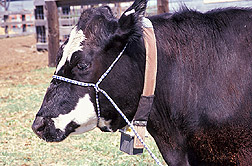| 
Cow equipped with a GPS collar, used to track the
location of the animal. Click the image for more information about
it.
|
Water, But
Not Salt, Effective in Changing Grazing Patterns
By David
Elstein
October 20, 2004 Ranchers have traditionally used
water and salt to move cattle from one place to another--to prevent
overgrazing, for example. Now an Agricultural Research Service rangeland
scientist has found that, while water is an effective tool for moving cattle,
salt isn't as helpful as was once thought, at least on sagebrush steppe
rangeland.
David C.
Ganskopp tracked the movement of cattle on large western rangelands by
putting Global Positioning System collars on them to determine their precise
location. At the ARS
Range
and Meadow Forage Management Research Unit in Burns, Ore., Ganskopp
observed that cattle were attracted to water nine times more often than they
were to salt.
They were willing to travel farther to get to water, and whenever water and
salt were separated, they altered their habits to remain close to water. Since
water is required on nearly a daily basis by cattle, the animals will alter
their distribution patterns to remain near dependable water sources.
According to Ganskopp, cows have the ability to learn and remember, thus
knowing how to find water sources that they've previously visited. If producers
selectively open and close gates to watering points on the range or move
portable water tanks to unused points in the pasture, they can get the animals
to occupy these under-grazed areas.
While the salt will likely not attract cattle for great distances, it is an
excellent carrier for supplementing their diets with the many minerals needed
to sustain animal gains and reproduction. For those reasons, salt should still
be readily accessible to cattle.
Ganskopp is continuing analyses of his cattle data with geographic
information system software to evaluate the effects on livestock distribution
of topography, forage quantity and forage quality differences.
ARS is the U.S. Department of
Agriculture's chief scientific research agency.
|